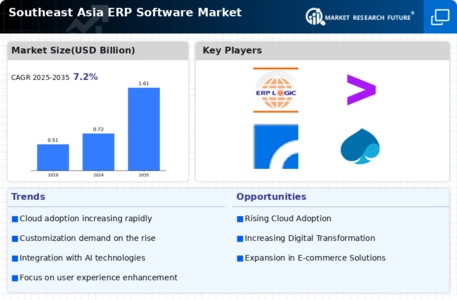Rising Demand for Automation
Automation is becoming a pivotal driver in the Global Southeast Asia ERP Software Market Industry. Companies are increasingly seeking ERP solutions that incorporate automation features to enhance operational efficiency and reduce manual errors. This demand is fueled by the need for faster processing times and improved accuracy in business operations. As organizations strive to remain competitive, the integration of automated processes within ERP systems is likely to gain traction. This trend may contribute to the market's growth, as businesses recognize the potential of automation to transform their operational frameworks.
Increasing Adoption of Cloud Solutions
The Global Southeast Asia ERP Software Market Industry is witnessing a notable shift towards cloud-based solutions. Organizations are increasingly adopting cloud ERP systems due to their scalability, cost-effectiveness, and accessibility. In 2024, the market is projected to reach 0.72 USD Billion, driven by the need for real-time data access and remote collaboration. Businesses are leveraging cloud ERP to streamline operations and enhance decision-making processes. This trend is expected to continue, as more enterprises recognize the benefits of cloud technology, potentially leading to a more integrated and efficient business environment.
Regulatory Compliance and Risk Management
Regulatory compliance and risk management are becoming critical factors in the Global Southeast Asia ERP Software Market Industry. With evolving regulations across various sectors, organizations are compelled to adopt ERP solutions that facilitate compliance and mitigate risks. ERP systems equipped with compliance features help businesses adhere to legal requirements, thereby reducing the likelihood of penalties. This growing emphasis on compliance is likely to drive the adoption of ERP solutions, as organizations prioritize risk management and operational integrity in their strategic planning.
Emergence of Industry-Specific ERP Solutions
The emergence of industry-specific ERP solutions is a notable trend within the Global Southeast Asia ERP Software Market Industry. Tailored ERP systems designed for specific sectors are gaining traction as businesses seek solutions that address their unique operational challenges. This trend is indicative of a broader shift towards customization in ERP offerings, allowing organizations to optimize their processes more effectively. As the market evolves, the demand for specialized ERP solutions is expected to grow, potentially enhancing the overall efficiency and productivity of various industries.
Focus on Data Analytics and Business Intelligence
The emphasis on data analytics and business intelligence is reshaping the Global Southeast Asia ERP Software Market Industry. Organizations are increasingly utilizing ERP systems that offer advanced analytics capabilities to derive actionable insights from their data. This trend is driven by the need for informed decision-making and strategic planning. As businesses aim to leverage data for competitive advantage, the integration of analytics within ERP solutions is expected to grow. This focus on data-driven strategies may significantly influence the market, as companies seek to enhance their operational effectiveness and responsiveness.















Leave a Comment